The Fishes of Lake Garda
In the past, fishing and olive cultivation were the main sources of income. Today there are only a few fishermen left. Most of them are in Garda, where the fishing cooperative sells both fresh and smoked fish in Via Antiche Mura every day. An area that is rich in fish is the so-called “Peschiera di San Vigilio”, which includes the "Secca del Vò" (shallow of Vò), an underwater mountain in the lake water, in front of Bardolino.
Alosa Agone (Alosa fallax lacustris)
 This fish lives in school and was, as the common bleak, a basic sustenance during the famine periods of the past centuries. It lives in large schools in inland lakes and is usually to be found in the pelagic zone. In winter, it remains in the depth, while in summer it sometimes comes to the Lake surface in the littoral zone. It feeds almost exclusively on plankton and, rarely, on small species that live on the lake bottom. It reaches a maximum length of 35 to 40 cm and its life span is around 7 or 8 years. In Lake Garda the agone schools include thousands of individuals of the same age. Its meat is tasty and slightly fatty. Its aroma is best in autumn and winter when the fish reaches its maximum size.
This fish lives in school and was, as the common bleak, a basic sustenance during the famine periods of the past centuries. It lives in large schools in inland lakes and is usually to be found in the pelagic zone. In winter, it remains in the depth, while in summer it sometimes comes to the Lake surface in the littoral zone. It feeds almost exclusively on plankton and, rarely, on small species that live on the lake bottom. It reaches a maximum length of 35 to 40 cm and its life span is around 7 or 8 years. In Lake Garda the agone schools include thousands of individuals of the same age. Its meat is tasty and slightly fatty. Its aroma is best in autumn and winter when the fish reaches its maximum size.
Common bleak (Alburnus alburnus)
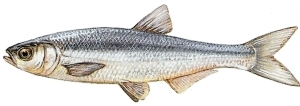 The common bleak is a thin and small fish. Its mouth is rather small and clearly oblique; its lower jaw is slightly protruding. Its maximum length is 15 cm, and its maximum weight 50 g. This fish has very gregarious habits; it lives in huge schools of fish, both in running waters and in lakes. It loves clear and warm waters and avoids murky ones with too much vegetation or a low quantity of oxygen. The fish has a very varied diet. It eats insects, oligochaete and crustaceans but it mainly feeds on phytoplankton. The common bleak is an important part of the food chain of many aquatic ecosystems, as it is the main food source of many predators like pike, trout and perch. Its population is declining due to massive fishing, increasing water pollution and a big quantity of animals around the lake feeding on this fish, like cormorants and seagulls. This common bleak has been the daily staple of the inhabitants of the Lake Garda region for centuries. It is tasty and can be cooked in different ways. Eaten fresh, preserved under salt or sun-dried, it is always delicious. Due to its small size, it is also easy to fry. You can still find people who brine it in order to use it as a sauce for the typical bigoli pasta... a great dish from the Lake Garda tradition!
The common bleak is a thin and small fish. Its mouth is rather small and clearly oblique; its lower jaw is slightly protruding. Its maximum length is 15 cm, and its maximum weight 50 g. This fish has very gregarious habits; it lives in huge schools of fish, both in running waters and in lakes. It loves clear and warm waters and avoids murky ones with too much vegetation or a low quantity of oxygen. The fish has a very varied diet. It eats insects, oligochaete and crustaceans but it mainly feeds on phytoplankton. The common bleak is an important part of the food chain of many aquatic ecosystems, as it is the main food source of many predators like pike, trout and perch. Its population is declining due to massive fishing, increasing water pollution and a big quantity of animals around the lake feeding on this fish, like cormorants and seagulls. This common bleak has been the daily staple of the inhabitants of the Lake Garda region for centuries. It is tasty and can be cooked in different ways. Eaten fresh, preserved under salt or sun-dried, it is always delicious. Due to its small size, it is also easy to fry. You can still find people who brine it in order to use it as a sauce for the typical bigoli pasta... a great dish from the Lake Garda tradition!
Eel (Anguilla anguilla)
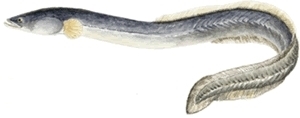 It is an elongated fish, cylindrical in the anterior part and flat in the posterior one. Its skin secrets mucus, which makes it very slimy. Eel is a predator; it feeds mainly on crustaceans, worms, various molluscs, amphibious, fish eggs and small fish. Eel is active at night. It migrates from the lake to spawn in seawater and then the little larvae drift back towards the place of their “ancestors” in the freshwater. Today, it is quite sure that the European eel spawns in the Atlantic Ocean. The Lake Garda eel, however, is brought by man, as it is not able possible to reach the ocean anymore due to the construction of dams along the Mincio river. The female eel can live up to 40 years, reach a maximum length of 1,5 m and a weight of 6 kg. Male eel very rarely live more than 15 years. The meat is fatty and tasty. The Lake Garda eel is very delicious and can be found in stable numbers, thanks to correct fish raising methods.
It is an elongated fish, cylindrical in the anterior part and flat in the posterior one. Its skin secrets mucus, which makes it very slimy. Eel is a predator; it feeds mainly on crustaceans, worms, various molluscs, amphibious, fish eggs and small fish. Eel is active at night. It migrates from the lake to spawn in seawater and then the little larvae drift back towards the place of their “ancestors” in the freshwater. Today, it is quite sure that the European eel spawns in the Atlantic Ocean. The Lake Garda eel, however, is brought by man, as it is not able possible to reach the ocean anymore due to the construction of dams along the Mincio river. The female eel can live up to 40 years, reach a maximum length of 1,5 m and a weight of 6 kg. Male eel very rarely live more than 15 years. The meat is fatty and tasty. The Lake Garda eel is very delicious and can be found in stable numbers, thanks to correct fish raising methods.
Common barbel (Barbus barbus)
 The common barbel has four characteristic whiskerlike structures called barbels, at the corners of its mouth, a slender body and rather big scales. It lives in the ground areas in running waters of rivers, rarely lakes, and prefers clear and cold water with a gravelly, stony or sandy bottom. It is a gregarious species living in big schools. This fish feeds on worms, molluscs, insect larvae, eggs and broods of other fish and sometimes aquatic plant litter. It can exceed 60 cm in length remaining normally under 4 kg of weight. It is not very appreciated as food, mainly because its eggs and ovaries are toxic for us and cause stomach ache.
The common barbel has four characteristic whiskerlike structures called barbels, at the corners of its mouth, a slender body and rather big scales. It lives in the ground areas in running waters of rivers, rarely lakes, and prefers clear and cold water with a gravelly, stony or sandy bottom. It is a gregarious species living in big schools. This fish feeds on worms, molluscs, insect larvae, eggs and broods of other fish and sometimes aquatic plant litter. It can exceed 60 cm in length remaining normally under 4 kg of weight. It is not very appreciated as food, mainly because its eggs and ovaries are toxic for us and cause stomach ache.
Burbot (Lota lota)
 The Burbot, a nocturnal animal, is primarily a piscivore, eating especially fish eggs. It lives at the bottom of lakes and slow flowing streams, in clear and fresh water. It feeds mainly on aquatic larvae, earthworms, dead and living fish. This strange benthic fish, similar to the sea codfish, can reach 60 cm in length and 3 or 4 kg in weight. The flesh of the biggest fish is white and without bones; it is very tasty despite the ungraceful shape of this fish.
The Burbot, a nocturnal animal, is primarily a piscivore, eating especially fish eggs. It lives at the bottom of lakes and slow flowing streams, in clear and fresh water. It feeds mainly on aquatic larvae, earthworms, dead and living fish. This strange benthic fish, similar to the sea codfish, can reach 60 cm in length and 3 or 4 kg in weight. The flesh of the biggest fish is white and without bones; it is very tasty despite the ungraceful shape of this fish.
Common Carp (Cyprinus carpio)
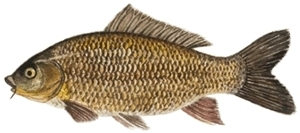 It is an allochthonous fish species native to Asia and introduced to Italy in ancient times. It lives mainly in ponds, river tributaries, canals, small lakes and wherever there is warm water and no or very weak current, muddy bottom and submerged vegetation. The carp is omnivorous. However, it feeds mainly on invertebrates and plant substances. It can reach the considerable size of 80/100 cm and a weight of over 20 kg. It tolerates difficult environmental conditions and is able to live in waters with low oxygen levels. It is appreciated especially in the kitchen of the southern Lake Garda. It has fat but delicious meat with an intense taste.
It is an allochthonous fish species native to Asia and introduced to Italy in ancient times. It lives mainly in ponds, river tributaries, canals, small lakes and wherever there is warm water and no or very weak current, muddy bottom and submerged vegetation. The carp is omnivorous. However, it feeds mainly on invertebrates and plant substances. It can reach the considerable size of 80/100 cm and a weight of over 20 kg. It tolerates difficult environmental conditions and is able to live in waters with low oxygen levels. It is appreciated especially in the kitchen of the southern Lake Garda. It has fat but delicious meat with an intense taste.
Lake Garda Carpione (Salmo carpio)
 It is a salmonid fish that lives exclusively in Lake Garda. Even though it has teeth, it feeds on zooplankton and bottom-living crustaceans. The female has a consistent silver colour throughout the year, whereas the male develops a very dark, often black colour during pairing season. To an inexperienced eye, it may be confused with the lake trout that also has black spots arranged to form an X on the side. Ideal habitat is the southern Lake Garda, where it finds enough food. However, during the breeding season it also moves to the middle and northern lake to live on deep, clean and gravelly bottoms. The meat is white or pink, very tender and delicious.
It is a salmonid fish that lives exclusively in Lake Garda. Even though it has teeth, it feeds on zooplankton and bottom-living crustaceans. The female has a consistent silver colour throughout the year, whereas the male develops a very dark, often black colour during pairing season. To an inexperienced eye, it may be confused with the lake trout that also has black spots arranged to form an X on the side. Ideal habitat is the southern Lake Garda, where it finds enough food. However, during the breeding season it also moves to the middle and northern lake to live on deep, clean and gravelly bottoms. The meat is white or pink, very tender and delicious.
Common chub (Leuciscus cephalus)
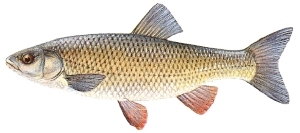 It is probably the most common cyprinid and one of the easiest to spot because it likes to stay close to the shore. It has a torpedo-shaped body with a big head. The body is slender and massive at the same time. It has a big, slightly oblique mouth and is practically omnivorous: it feeds on anything that can be eaten in water: crustaceans on the bottom, insects on the surface, fruits fallen from trees and even cloacal waste. As an adult, he becomes a predator and eagerly eats small fish, in particular common bleak. The fish can reach considerable dimensions: up to 60 cm of length and 3-4 kg of weight. Reproduction lasts from April to July or beyond, depending on seasonal evolution and the thermal cycles of the various habitats. During the pairing season, the chub moves in large schools to shallow water. It is very common to see females of considerable size, followed by dozens of much smaller males.
It is probably the most common cyprinid and one of the easiest to spot because it likes to stay close to the shore. It has a torpedo-shaped body with a big head. The body is slender and massive at the same time. It has a big, slightly oblique mouth and is practically omnivorous: it feeds on anything that can be eaten in water: crustaceans on the bottom, insects on the surface, fruits fallen from trees and even cloacal waste. As an adult, he becomes a predator and eagerly eats small fish, in particular common bleak. The fish can reach considerable dimensions: up to 60 cm of length and 3-4 kg of weight. Reproduction lasts from April to July or beyond, depending on seasonal evolution and the thermal cycles of the various habitats. During the pairing season, the chub moves in large schools to shallow water. It is very common to see females of considerable size, followed by dozens of much smaller males.
Coregone Lavarello (Coregonus lavaretus)
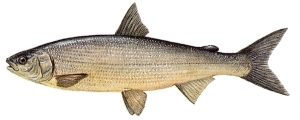 One of the finest fish of Lake Garda. It is medium-sized and 30 to 50 cm long. Sometimes it can reach a length of 80 cm and a weight of 4 kg. It is easy recognizable by its special pupil. The name coregonus means angled pupil and, in fact, its pupil has a characteristic shape that ends angled. It is not native to Lake Garda. More than a million juvenile fish were introduced by humans in 1918. Today it is a very common specimen due to man-made constant repopulation. It feeds almost exclusively on plankton (composed of non-autonomous animal organisms that live in the water and let themselves carry by the currents and are the base of all food chains in the sea and in the lake). Sometimes it feeds of insect larvaes or small crustaceans and molluscs. It prefers deep, clear and oxygen-rich water and is very sensitive to pollution. In winter, when it reproduces, it moves to the shallower and calmer waters on the shores. The meat is white, delicate and very much appreciated. It is low in fat, rich in omega 3, easily to digest and has only a few bones.
One of the finest fish of Lake Garda. It is medium-sized and 30 to 50 cm long. Sometimes it can reach a length of 80 cm and a weight of 4 kg. It is easy recognizable by its special pupil. The name coregonus means angled pupil and, in fact, its pupil has a characteristic shape that ends angled. It is not native to Lake Garda. More than a million juvenile fish were introduced by humans in 1918. Today it is a very common specimen due to man-made constant repopulation. It feeds almost exclusively on plankton (composed of non-autonomous animal organisms that live in the water and let themselves carry by the currents and are the base of all food chains in the sea and in the lake). Sometimes it feeds of insect larvaes or small crustaceans and molluscs. It prefers deep, clear and oxygen-rich water and is very sensitive to pollution. In winter, when it reproduces, it moves to the shallower and calmer waters on the shores. The meat is white, delicate and very much appreciated. It is low in fat, rich in omega 3, easily to digest and has only a few bones.
Pike (Exos lucius)
 Pike can be found in almost all waters in the plains, especially in Karst springs. The fish loves areas of slow running or stagnant waters like river branches, if provided with vegetation and reed where it can hide waiting for small fish to feed on. However, as a juvenile it lives on invertebrates. Occasionally it also feeds on small marsh birds, amphibians, rodents and water snakes. Pike can reach more than one metre in Lake Garda. It is popular with both, professional and amateur, fishermen due to its delicious white and firm meat.
Pike can be found in almost all waters in the plains, especially in Karst springs. The fish loves areas of slow running or stagnant waters like river branches, if provided with vegetation and reed where it can hide waiting for small fish to feed on. However, as a juvenile it lives on invertebrates. Occasionally it also feeds on small marsh birds, amphibians, rodents and water snakes. Pike can reach more than one metre in Lake Garda. It is popular with both, professional and amateur, fishermen due to its delicious white and firm meat.
European Perch (Perca fluviatilis)
 The European perch is a fish of medium size that can reach up to 45-50 cm and 1.5 kg. However, the size varies greatly from environment to environment, the more fish there are, the slower it grows. The juvenile perch, up to a length of 10-13 cm, consumes mostly zooplankton, insect larvae, worms and small crustaceans. Later, it begins to hunt other fish species, especially the common bleak. The European perch is appreciated by all fishermen. It offers very delicate and tasty white meat underneath the thick protective "skin".
The European perch is a fish of medium size that can reach up to 45-50 cm and 1.5 kg. However, the size varies greatly from environment to environment, the more fish there are, the slower it grows. The juvenile perch, up to a length of 10-13 cm, consumes mostly zooplankton, insect larvae, worms and small crustaceans. Later, it begins to hunt other fish species, especially the common bleak. The European perch is appreciated by all fishermen. It offers very delicate and tasty white meat underneath the thick protective "skin".
Largemouth bass (Micropterus salmoides)
 The largemouth bass is originally from North America. It was introduced to the Italian lakes at the beginning of this century. It is a predator, feeding mainly on animals. Younger fish, who live near the surface, feed on macroinvertebrates (insect larvae, small worms, small insects with wings), whereas adults, who are near the ground, hunt amphibians and small fish, sometimes also of the same species. The largemouth bass, like the pike, lurks in the shelter of underwater vegetation waiting for possible prey but also chases his prey, as the perch. It grows up to 60 cm and can reach a weight of 6 or 7 kg. Like the meat of most predators, it is highly appreciated.
The largemouth bass is originally from North America. It was introduced to the Italian lakes at the beginning of this century. It is a predator, feeding mainly on animals. Younger fish, who live near the surface, feed on macroinvertebrates (insect larvae, small worms, small insects with wings), whereas adults, who are near the ground, hunt amphibians and small fish, sometimes also of the same species. The largemouth bass, like the pike, lurks in the shelter of underwater vegetation waiting for possible prey but also chases his prey, as the perch. It grows up to 60 cm and can reach a weight of 6 or 7 kg. Like the meat of most predators, it is highly appreciated.
Tench (Tinca tinca)
 The tench lives in stagnant or slow-flowing waters with muddy substrate and abundant vegetation. In winter, it remains almost motionless in the mud. It feeds on animals living on the bottom like worms, insect larvae, crustaceans and snails, which can be found on plants. The fish is yellowish green with golden reflections. It has black fins, two very short barbels on his mouth and small scales with a thick layer of mucus. It can reach between 2 and 4 kg and between 50 and 60 cm. The fish is very adaptable. It grows at temperatures between 5 and 30 degrees and tolerates water low in oxygen. Its resistance makes it the perfect breeding fish. Its meat has a medium fat content, is tender and tasty. In summer, the meat might taste like mud. This can be easily prevented by putting the living fish in clean water for some time.
The tench lives in stagnant or slow-flowing waters with muddy substrate and abundant vegetation. In winter, it remains almost motionless in the mud. It feeds on animals living on the bottom like worms, insect larvae, crustaceans and snails, which can be found on plants. The fish is yellowish green with golden reflections. It has black fins, two very short barbels on his mouth and small scales with a thick layer of mucus. It can reach between 2 and 4 kg and between 50 and 60 cm. The fish is very adaptable. It grows at temperatures between 5 and 30 degrees and tolerates water low in oxygen. Its resistance makes it the perfect breeding fish. Its meat has a medium fat content, is tender and tasty. In summer, the meat might taste like mud. This can be easily prevented by putting the living fish in clean water for some time.
Brown trout (Salmo trutta)
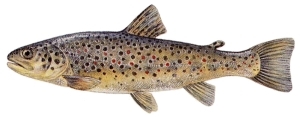 The trout is called the queen of the lake. The species is less and less common in Lake Garda. It reproduces in the last part of the Sarca tributary of Lake Garda and in some parts of the Toscolano river on the western shore. It can reach a length of more than 1 m and a weight of up to 20 kg. It is endemic to the lake and feeds on small fish. There are three trout species in the lake: brown trout, riverine brown trout and rainbow trout. The first is indigenous to the lake and reproduces; the other two depend on fish restocking. Trouts are carnivores and predators, feeding on invertebrates and later on young and small fish. The meat is really excellent, very tasty, especially of larger ones. It is firm and without bones, white or, if fed on shellfish, pink. All trout species are a delight for the palate.
The trout is called the queen of the lake. The species is less and less common in Lake Garda. It reproduces in the last part of the Sarca tributary of Lake Garda and in some parts of the Toscolano river on the western shore. It can reach a length of more than 1 m and a weight of up to 20 kg. It is endemic to the lake and feeds on small fish. There are three trout species in the lake: brown trout, riverine brown trout and rainbow trout. The first is indigenous to the lake and reproduces; the other two depend on fish restocking. Trouts are carnivores and predators, feeding on invertebrates and later on young and small fish. The meat is really excellent, very tasty, especially of larger ones. It is firm and without bones, white or, if fed on shellfish, pink. All trout species are a delight for the palate.
foto fonte www.amicidelgondolin.it